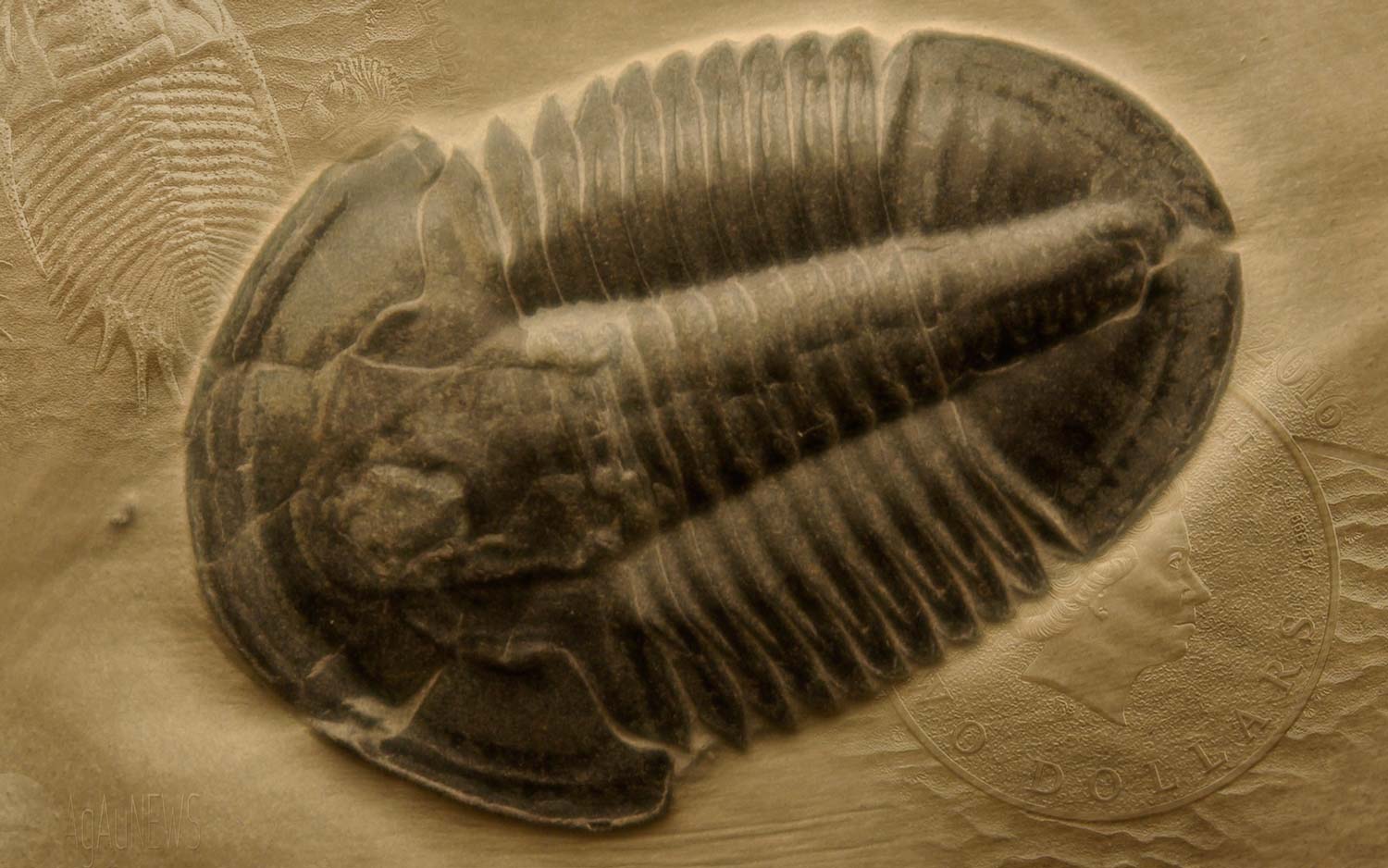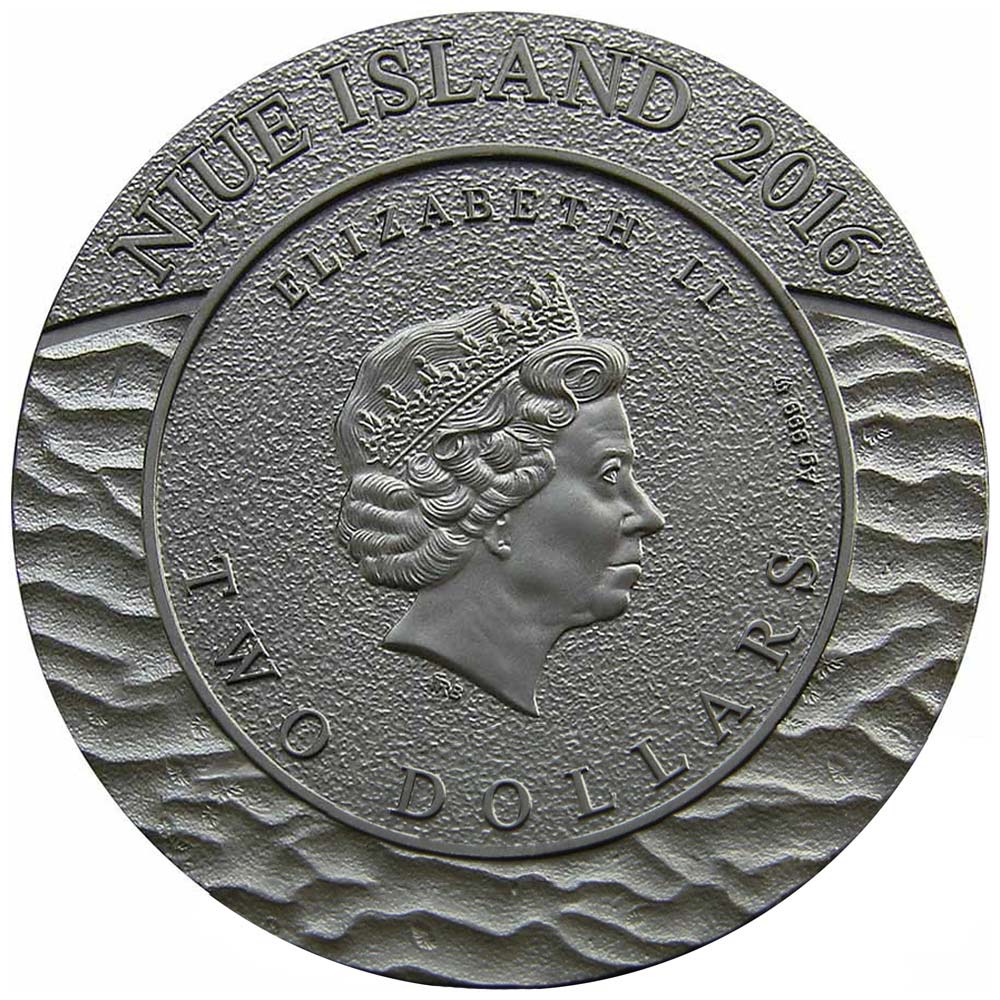One of our highlights from 2015 was a coin from Liechtensteins Coin Invest Trust that came from nowhere and became an instant hit. Called Evolution of Life, it was struck in fine silver to a high-relief, partly antiqued, and depicted a rose-gold plated ammonite fossil protruding from rock. Issued for Mongolia, like many of CIT’s best nature coins, it rapidly began to appreciate with many collectors, myself definitely included, eagerly awaiting the next one. As a producer that likes to experiment, CIT are clearly used to being emulated, but the Mint of Poland are the first to have jumped into the ring, surprising given they’re great innovators and experimenters in their own right.
This new Niue-issued coin is two-ounces in weight and the first in a new series called Evolution of Earth, a title almost guaranteed to draw comparison to the CIT effort. There are some fundamental differences outside of the doubling in weight. Instead of an antique-finish, the hit finish of the last couple of years, the mint has gone with a new darling of the numismatic world, Ruthenium plating, a metal giving a black finish and creating a fine contrast to the gold plating that’s been applied to the high-relief parts of the coin. The gilding extends to the coins edge, there’s no rim, and the obverse is fully ruthenium plated.
The design is attractive enough, choosing to represent the animal in a more lifelike pose than the fossilised look of the Ammonite coin, and is struck in a very high relief (up to 3.7mm), looking especially impressive due to the rest of the coin face being relatively flat. The trilobite is gilded and exhibits a fine level of detail. The background replicates an ancient seabed with several other ungilded creatures within. The rimless design and minimal inscriptions keep it all looking clean, our only negative being the trilobite appears to sit on, rather than in the design like CIT’s ammonite coin. The obverse carries over the seabed imprint, but in other regards is a typical Niue coin, carrying an effigy of Queen Elizabeth II, in this case that by Ian Rank Broadley.
The packaging looks decent enough, typical for the Mint of Poland, and the mintage is set at 666 pieces, an odd number we can see no real reason for. The coin is up for pre-order at many dealers right now. It’s priced in the €200-250 ($220-270) range which is fairly typical. We look forward to the next one. In the meantime, this one has an absolutely fascinating subject and we cannot recommend enough that you find out more about these fantastic creatures, one of the most diverse in history, and which may have, in one form or another, been common on earth for almost 350 million years.
TRILOBITES
Trilobites, meaning “three lobes”, are a fossil group of extinct marine arthropods that form the class Trilobita. Trilobites form one of the earliest known groups of arthropods. The first appearance of trilobites in the fossil record defines the base of the Atdabanian stage of the Early Cambrian period (521 million years ago), and they flourished throughout the lower Paleozoic era before beginning a drawn-out decline to extinction when, during the Devonian, all trilobite orders except the Proetids died out. Trilobites finally disappeared in the mass extinction at the end of the Permian about 250 million years ago. The trilobites were among the most successful of all early animals, roaming the oceans for over 270 million years.
By the time trilobites first appeared in the fossil record, they were already highly diversified and geographically dispersed. Because trilobites had wide diversity and an easily fossilized exoskeleton, an extensive fossil record was left behind, with some 17,000 known species spanning Paleozoic time. The study of these fossils has facilitated important contributions to biostratigraphy, paleontology, evolutionary biology, and plate tectonics.
Trilobites had many lifestyles; some moved over the sea bed as predators, scavengers, or filter feeders, and some swam, feeding on plankton. Most lifestyles expected of modern marine arthropods are seen in trilobites, with the possible exception of parasitism. All trilobites are thought to have originated in present-day Siberia, with subsequent distribution and radiation from this location.
Trilobites appear to have been exclusively marine organisms, since the fossilized remains of trilobites are always found in rocks containing fossils of other salt-water animals such as brachiopods, crinoids, and corals. Within the marine paleoenvironment, trilobites were found in a broad range from extremely shallow water to very deep water. Trilobites, like brachiopods, crinoids, and corals, are found on all modern continents, and occupied every ancient ocean from which Paleozoic fossils have been collected. The remnants of trilobites can range from the preserved body to pieces of the exoskeleton, which it sheds in the process known as ecdysis. In addition, the tracks left behind by trilobites living on the sea floor are often preserved as trace fossils.
Trilobite fossils are found worldwide, with many thousands of known species. Because they appeared quickly in geological time, and moulted like other arthropods, trilobites serve as excellent index fossils, enabling geologists to date the age of the rocks in which they are found. They were among the first fossils to attract widespread attention, and new species are being discovered every year.
When trilobites are found, only the exoskeleton is preserved in all but a handful of locations. A few locations preserve identifiable soft body parts (legs, gills, musculature & digestive tract) and enigmatic traces of other structures (e.g. fine details of eye structure) as well as the exoskeleton.
Trilobites range in length from minute (less than 3 millimetres (0.12 in)) to very large (over 30 centimetres (12 in)), with an average size range of 3–10 cm (1.2–3.9 in). Supposedly the smallest species is Acanthopleurella stipulae with a maximum of 1.5 millimetres (0.059 in). The world’s largest known trilobite specimen, assigned to Isotelus rex of 72 cm, was found in 1998 by Canadian scientists in Ordovician rocks on the shores of Hudson Bay. (Source: Wikipedia)
ADVERTISEMENTS












ordered a few days ago at FCC https://firstcoincompany.com/S/niue-island-trilobites-series-evolution-of-earth-silver-coin-2-ruthenium-and-gold-plated-2016-ultra-high-relief-2-oz
This is the fourth comment on the trot looking like an advert mate. No more please.